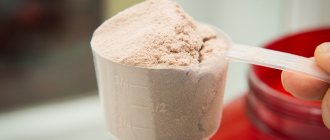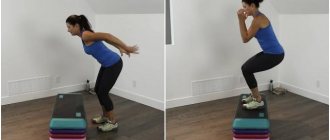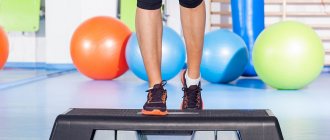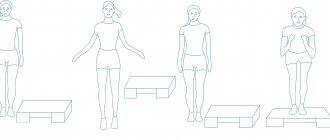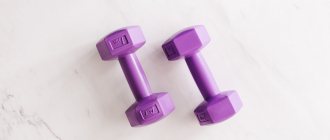Even simple everyday activities involve a complex sequence of tension and relaxation of various muscles. We use most of these movements frequently throughout our lives, which means we perform them more quickly, smoothly and accurately.
With regular practice, even complex movements such as cycling, knitting or playing a musical instrument can be performed automatically and without thinking. It's all about muscle memory. Alexander Karpov helps you figure out what it is and how to use it.
.
How to train to develop lagging muscles? Pro Tips
What is muscle memory
Muscle memory is a restructuring of muscle cells that occurs under the influence of physical training.
Norwegian scientists from the University of Oslo have proven that muscle fibers have their own memory, and its mechanism is associated with the appearance of new nuclei in them. Scientists have associated muscle growth with an increase in the number of nuclei in cells. A larger number of working genes made it possible to synthesize more actin and myosin - muscle contractile proteins. Contrary to initial expectations, the nuclei did not disappear with decreasing intensity and level of muscle load. During three months of muscle atrophy, they remained in standby mode, and with the resumption of training they began to actively function, enhancing protein synthesis and hypertrophic processes.
The concept of muscle memory and how it works
The definition of the above term reads as follows: “This is the ability of the human body to remember the level of muscle tone acquired during physical activity, as well as restore it in the shortest possible time after a long break.”
This concept can be clearly explained using the following example. You trained for a long time, got into sports shape. But suddenly, for some reason, you had to stop the program, for example, due to illness, moving, or going on maternity leave. After a while you decide to return to the hall. At the same time, you will achieve the desired results faster than a beginner athlete. This is due to the fact that the muscles acquire their former state thanks to the remaining information that is stored in them.
How it works in practice
You go to the gym, run, exercise, burn weight or gain muscle mass. After you become successful in your endeavor, you suddenly have to take a break from training. The reasons can be any: injury, birth of a child, change of job, financial difficulties, military service. For most athletes, a forced break causes unpleasant emotions. Many people think that now everything will have to start from scratch. This is wrong.
Athletes who have already achieved certain results get back into shape much more easily than beginners. Everything will depend on the individual characteristics of the body, the intensity of training, the duration of the break and the degree of muscle atrophy during this period, but on average an athlete manages to restore his former shape in three months.
You may remember that one of these legendary comebacks was Arnold Schwarzenegger's decision to compete in the Mr. Olympia competition and win for the seventh time in 1975.
Mechanism of operation
When muscles are stressed during any activity (be it strength training or playing a musical instrument), motor neurons located in the right hemisphere of the brain send signals to muscle fibers. Then the opposite situation occurs - the muscles also send their signals to the brain.
Thus, a kind of connection is created, and the more we improve in our chosen field, the stronger it becomes. Therefore, having learned something once (for example, cycling or swimming), it will be very easy to reproduce this skill even after a long break. This is how muscle memory develops.
Also, muscle fiber cells contain a large number of nuclei. During active exercise, their number increases, and with them the amount of myosin and actin, the parts of DNA responsible for the synthesis of contractile proteins, also increases. The volume of muscle mass also increases. When training stops, the body spends fewer resources, synthesis slows down, and the muscles lose shape.
But new nuclei formed as a result of physical activity do not disappear. When they resume exercise, they will be able to return the muscles to their original volume and strength.
How to use muscle memory
The phenomenon of muscle memory is another example of how amazingly human beings are. But this does not mean that there is no room for several life hacks that we ourselves can do with our bodies.
Don't be afraid to stop training
Your muscle memory is the key to the fact that after a long break you will return to the gym, track or ring without much effort. This is your capital and a guarantee that all your training, efforts and achievements were not in vain. Thanks to muscle memory, you can calmly stop your training for a while and not worry about missed opportunities.
Take breaks to achieve results
To some extent, the phenomenon of muscle adaptation to stress is associated with the phenomenon of muscle memory. At a certain point, you reach a plateau when your muscles are already accustomed to the weights and exercises, so there is no progress. In this situation, you can temporarily stop training.
Thanks to muscle memory, you don’t have to worry about not being able to get back to the results you achieved. And after a deliberate break, you can gradually begin to train with renewed vigor in order to take on new weights, see progress, and move from a dead point.
Work on your technique
Even if you haven't ridden a bike in 10 years, you can get on it and pedal successfully. This is also due to muscle memory. Your muscles remember the technique of performing exercises. After returning to the gym, you will not have to learn how to squat correctly again, and after returning to the ring you will not have to re-punch. Efforts to restore equipment will be minimal.
Muscle memory is another gift from nature, a hidden resource that testifies to our enormous potential. Don't neglect it.
Steroids and new nuclei
Let’s immediately dispel all myths and doubts; training on anabolic steroids, in the same way, increases the number of new nuclei in muscle cells.
Steroids and new nuclei
Many people assume that the effects of taking steroids are temporary, but this is not entirely true. Yes, indeed, an athlete who took anabolic steroids, after leaving the “chemical course”, will “deflate”, muscles and strength will become much less, however, the number of new nuclei produced in muscle cells will remain at the same, high level, they will only lose their functionality for a while, therefore , the result gained from taking steroids can be considered permanent .
Another experiment by scientists showed that taking anabolic steroids leads to the formation of long-term cell memory. It was as follows:
Experimental mice took anabolic steroids (testosterone propionate) under physical activity for two weeks , followed by a break of 3 months (this time is 10% of their life), and again taking steroids under load was resumed, as a result, scientists observed how mice that took steroids, muscle mass grew much faster , myosatellite cells also divided at a high rate, compared to a group of mice that were not given anabolic steroids.
That is why athletes who take anabolic steroids, unlike naturals , even after a long break from the course, gain strength and endurance much faster. However, you have to pay for everything in this life; in this example, the athlete pays with his health. You can read more about the side effects of taking AAS here.
Using muscle memory
Muscle memory is the key to the fact that after interrupting training for forced reasons, a person will be able to regain the achieved results without putting much effort into it. Therefore, you should not be afraid to use it.
Interesting articles:
Abdominal exercises on the horizontal bar
How to charge a maintenance-free car battery
We conclude: it’s never too late to get back in shape
Muscle memory can be developed just like regular memory. It contains wonderful opportunities for a person:
- Regardless of age, muscle loss is a serious but modifiable condition.
- If you were once in good physical shape, then, having lost it, you can restore it even after time.
- Even if you give up training for a while, remember how muscle memory works and how long its potential is stored - in a body that was in good shape, muscle cells have already accumulated additional nuclei, so over the years it will be easier to deal with physical activity, than people who have never done anything.
Find out how girls can train correctly to spend less time but get better results here .
Improving muscle memory
Avoid Overtraining: Take Breaks
A study on long-term learning was published in the journal Current Biology. The exercise, which was performed four hours after the learning task, but not immediately after it, improved retention of associations and location images. At the same time, the brain structure responsible for memory, the hippocampus, was actively working. What does it mean? The brain needs to be given time to absorb information, including new motor skills. Change your activity, do something else, and the hippocampus will do its job at that time. To extend a new “power line” and grow nerve cell processes, building material and time will be needed. Therefore, you should not believe the promises “We’ll do the splits in two weeks” or “We’ll teach you how to jump an Axel in two days.”
Take your time
Any new movement begins with conscious study, when we mentally “pronounce” the algorithm of actions and carry it out step by step. Then the movement becomes automatic, and we don’t think about it, but just do it. It is important to take your time and make sure you are doing everything correctly, giving yourself the opportunity to slowly repeat the action a sufficient number of times. Correcting learned mistakes is difficult. To do this, you will need to wait until old neural connections weaken and new ones arise.
Get enough sleep
Eight hours of sleep gives the body the opportunity to recover. It is during rest hours that “debugging of minor bugs” in the functioning of internal organs occurs, and memories are consolidated - from short-term memory they are packed into long-term memory. Adequate sleep helps to minimize errors in “packaging” the experience gained and to learn new skills well.
Practice regularly
Spend time on the skill that you would like to master as best as possible. Movements become faster and more accurate with practice, and the motor pattern must be repeated regularly to maintain the neural connections that have emerged. You can skate for the rest of your life if you manage to master this skill once. However, you are unlikely to be able to jump an axel after years of lack of practice.
Any skills need to be mastered wisely: avoid excessive stress and excessive fatigue, but give yourself the opportunity to regularly practice what you want to do perfectly. And most importantly, don’t forget to enjoy the process!
WHAT HAPPENS IN THE BODY DURING TRAINING?
By repeating specific actions over and over again, we train the brain to perform various coordination movements automatically. The primary motor cortex of the brain is responsible for organizing such activity. As soon as a movement is memorized, information about it is sent to the brain’s archives – the subcortical nuclei. That is, even while performing various coordination movements, a person can think about completely unrelated things, he no longer cares about the process, because the muscles work without conscious participation.
In other words, during any exercise, a connection is established between the brain and muscle fibers. These fibers communicate with each other and “report” on the work performed: the weight lifted, the number of approaches, and so on. The brain processes this data, remembers and stores it. This is how a stable connection appears, namely muscle memory. That is, the more thoroughly and longer you train, the stronger it becomes.
How to develop and use muscle memory
Training muscle memory opens up horizons for engaging in any type of activity. The most important thing is that the results you achieve will remain forever. To achieve success in a certain sport, it is better to start playing it at a young age.
Long-term proper training and careful analysis will help improve muscle memory. To do this, it is better to use individually developed programs.
In strength sports, the help of an instructor or an experienced mentor will not hurt. This should be approached with particular seriousness. After all, if you do certain exercises incorrectly for a long time, this will not only harm the body, but will also be “imprinted” in the information that the muscles will use in the future.
The development of muscle memory can also be done on a psychological level. Such options are secondary and based on self-hypnosis, but they help to achieve results faster in combination with physical activity. At first, these methods seem pointless, but with intensive training they are very useful.
There are two ways:
- When going to bed, you need to close your eyes and imagine how perfect you would like your body to be. In this case, you need to wake up 2-3 times during the night and, when falling asleep, repeat the same manipulations again;
- Imagine a hot ball in your hands, fully feel it and begin to roll it over all parts of your body. Then imagine such a ball moving towards your throat. It needs to be redirected to the solar plexus, then to the hip area and finally to the legs. This psychological exercise is best done before bed and repeated 5 times. It seems to help break through new roads to nerve endings.
Does muscle memory work for any training? The answer is unequivocal - yes. The muscles fix the technique of performing various exercises, be it a barbell press or crawl swimming. Even after a long-term break, you will be able to remember how to do it correctly and return to your chosen field of activity.
Also, when you resume your training course, your joints and muscles will hurt less and you will remember how to recover quickly. In this regard, it is much more difficult for beginner athletes.
Now you know how to develop muscle memory, so temporarily stopping classes and losing the results you’ve gained shouldn’t scare you. Previous indicators can be restored in a fairly short time. But for this you need to exercise regularly and properly and develop your muscles.
How to develop muscle memory? Simple workouts for beginners
Like regular memory, muscle memory needs training. How to develop it? Set aside 15-20 minutes a day for physical activity - swim a couple of pools, play tennis, volleyball or football. The main thing is that you should like what you are going to do.
If it is not possible to train as stated above, or it is difficult to force yourself to do it, then start with at least 1-3 minutes and do these 5 simple exercises. Believe me, as soon as you start, the body itself will begin to “ask” for increased physical activity.
How to motivate yourself to exercise and stop planning a new life on Monday, read here .
So, start with easy exercises for development:
- Bridge from the floor 15 sec. (for buttocks and abdomen).
- Cycle 10 times (for the stomach and legs).
- Static plank 20 sec. (for arms, shoulders, stomach and back).
- Scissors from a lying position 30 times (for the abdomen and legs).
- Squats with calf raises 30 times (for legs, buttocks and arms).
what are the most common mistakes made by those who start practicing on their own at home.
